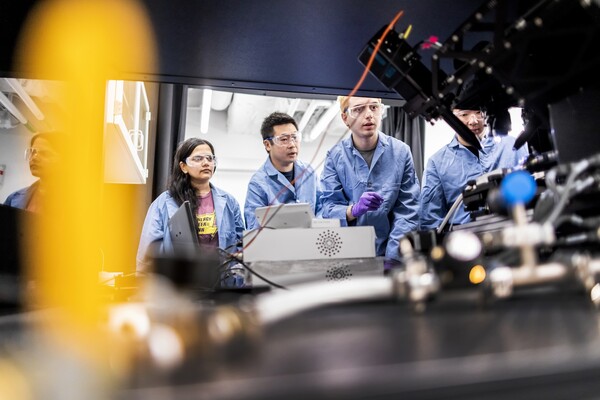
nocred

By now, most people have probably heard the phrase “Green New Deal.” Different iterations of the same idea have been kicking around for decades, through many congressional sessions and presidential administrations.
But when Rep. Alexandria Ocasio-Cortez (D-N.Y.) and Sen. Edward Markey (D-Mass.) introduced a non-binding resolution to Congress in February, they reignited the conversation in a way that Mark Alan Hughes, director of the Kleinman Center for Energy Policy at Penn, hasn’t seen in a long time, if ever before.
“What’s been missing in the U.S. for the past couple of years acutely, but even for longer, has been an unblinking statement of what it’s going to take to meet the challenges of climate change,” says Hughes, a professor of practice in the Stuart Weitzman School of Design. “Every single climate proposal, whether it’s coming from Democrats or Republicans—and some are now starting to emerge from Republicans—owes its backbeat to this Green New Deal vision.”
What does this latest proposal say and how close is the U.S. to making it a reality? Here, Hughes digs into the basics.
1. The proposal does lay out why climate change is urgent and the extent of its associated challenges. Recommendations in the text fall into two big buckets. The first relates to detailed climate goals backed by science from groups like the Intergovernmental Panel on Climate Change. And they’re a familiar chorus, for example, pointing to a need for net-zero greenhouse-gas emissions, protection against climate-related natural disasters, and clean, renewable, zero-emission sources providing 100% of U.S. power.
The second bucket, what Hughes calls the justice goals, aims to protect vulnerable, previously overlooked populations. Specifically, the resolution calls for “stopping current, preventing future, and repairing historic oppression” of many groups, including communities of color, poor and low-income workers, people with disabilities, and women.
“Broadly, these are all stated as goals, but really, they’re concerns and commitments,” Hughes says. “What the resolution stays silent on, which we’ve been trying to look at at the Kleinman Center, is the relationship between the climate and justice goals. A lot of the debate is about this.” In other words, do the authors think that only by meeting the justice goals can we also meet the climate goals? Or can they work in tandem?
2. The Green New Deal does not attach timetables or targets to most recommendations. Opponents of the plan have claimed, incorrectly, that investing in a high-speed rail will spell the end of air travel, that aiming for net-zero emissions means banning cows, and that the proposal’s total cost will reach $100 trillion.
“When people criticize it for envisioning an end state without airplanes, without cows, that’s just totally wrong,” Hughes explains. “When people, in a more sophisticated way, say that it’s about a complete, rapid transformation of the agriculture sector in 10 years, it doesn’t say that either.”
It does state that, in order to keep global temperatures from increasing by more than 1.5 degrees Celsius, the latest scientifically agreed-upon level needed to avoid the most severe climate-change effects, greenhouse gas emissions must drop at least 40% from 2010 levels by 2030 and get to net-zero by 2050. It also puts a 10-year time frame on national mobilization toward green progress. But that’s about it.
“Probably the most repeated phrase in the resolution is ‘as much as technically feasible,’” Hughes says. “It’s stated for just about everything, so there is lot of wiggle room.”
3. We’re probably the closest we’ve ever been to adopting such a plan. For starters, a majority of the Democrats who have joined the presidential race have proposed or back some type of Green New Deal–like energy transition.
Secondly, governments at the city and state level are active in this realm already. “States like California and Illinois are figuring out ways to credit lower carbon emissions from nuclear generation of electricity,” Hughes says. “It’s not the holy grail of a national price on carbon, but it does say, ‘The fact that you’re generating electricity with no carbon emissions, we value that, and we’ll pay you for it.’”
Finally, American attitudes about climate change are changing. Case in point, the most recent results from a long-running survey on the subject showed that 7 in 10 Americans now think global warming is happening and 6 in 10 understand humans are causing it.
“Great, Americans seem comfortable expressing a belief in and a commitment to doing something about climate change, but the proof of the pudding is in the taste. How much are they going to be willing to pay?” Hughes asks. “That’s a big step, and that’s why the Green New Deal is so important, because it normalizes the topic.”
4. There’s more work to do. “We’re a long way from solving this problem,” Hughes says. He has some concerns about the technical aspects of the current resolution language, whether it’s sufficient to help the United States get where it needs to quickly.
That said, “for years, people haven’t been proposing enough because they haven’t been proposing anything,” he adds. “You can’t work with silence. But with ideas that are not ambitious enough—I’ll take it.”
The appetite for any action on climate is especially great, given the environmental movement’s current defensive stance as Obama-era safeguards continue to get rolled back. “There are many industrial winners when we make changes to our energy policies,” Hughes notes. “Environmental protections are much more vulnerable. Even when they create enormous value to society, they still impose concentrated costs on industrial actors, and those actors have huge reasons to try to liberate themselves from those regulations.”
It’s unclear how far this version of the Green New Deal will progress. Two months after its proposal, it’s still sparking debate, like at a recent House Oversight Committee hearing. But that’s OK with Hughes, who’s up for any opportunity to keep the energy conversation fueled.
Mark Alan Hughes is founding faculty director of the Kleinman Center for Energy Policy and a professor of practice in the Stuart Weitzman School of Design at the University of Pennsylvania. He is also a faculty fellow of the Penn Institute for Urban Research, a senior fellow of the Wharton School’s Initiative for Global Environmental Leadership, and a distinguished scholar in residence at the Robert A. Fox Leadership Program.
Michele W. Berger

nocred

The sun shades on the Vagelos Institute for Energy Science and Technology.
nocred

Image: Kindamorphic via Getty Images

nocred